Artcurial will present a selection of nearly 200 lots at its Asian art auction
PARIS.- On 10 June, Artcurial will host an auction dedicated to Asian art. Comprising nearly 200 lots and several private collections, the sale will take us on a voyage throughout the Asian continent including several sections representing Japanese art followed by Chinese art, concluding with South-Eastern Asian art, in particular with pieces from India, Thailand, and Cambodia.
Chinese and Japanese art
Chinese art will be represented by several outstanding pieces such as a large Doucai porcelain dish, a legacy from the Qing Dynasty and Kangxi period (1662-1722). Decorated with dragons and Phoenix surrounded with peonies and foliage, it is marked with six Kangxi characters at the base (estimate: €30,000 - 40,000).
Lot 111. A Doucai porcelain dish, China, Qing dynasty, Kangxi mark and period (1662-1722). D. : 36,6 cm (4 ½ in.). Estimate €30,000 - €40,000. © Artcurial.
Circulaire, à décor de dragons et phénix entourés de pivoines et feuillages au centre et sur l'aile, le revers reprenant le même décor, marque à six caractères Kangxi à la base ; deux égrenures restaurées avec fêle associé pour une et petits manques d'émail restaurés sur la bordure.
Among these remarkable objects, a silver and gold-inlaid bronze jug dating from the Song-Ming dynasty (13th-15th century). This material is especially rare for a pouring vessel of this shape. Sublimated by a stylized high chiselled Gui dragon foot and a handle surmounted by the head of fantastic animal, it is estimated €25,000 - 35,000. Another noteworthy piece, a bowl covered in white jade from the Qing Dynasty and Qianlong period (1736-1795), the golden age of Chinese civilization. This object carries an estimate of between €12,000 and 18,000.
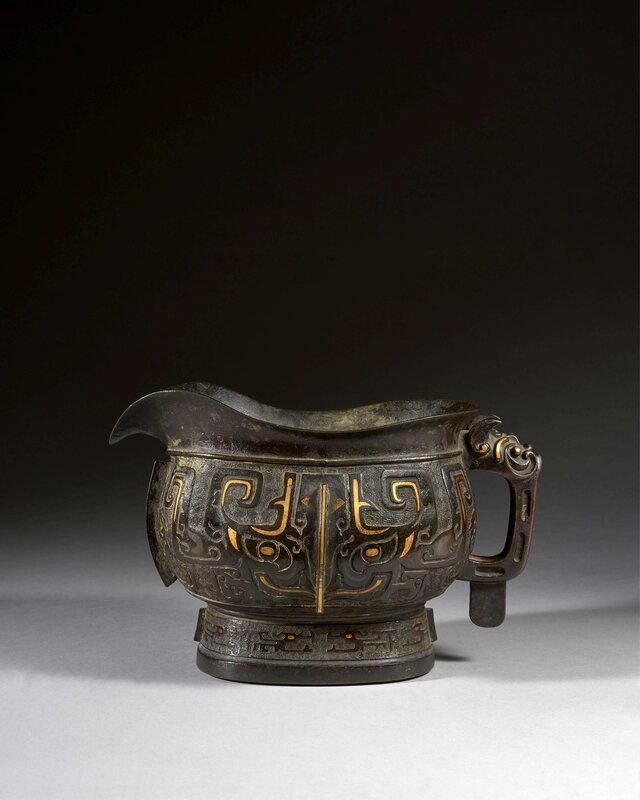
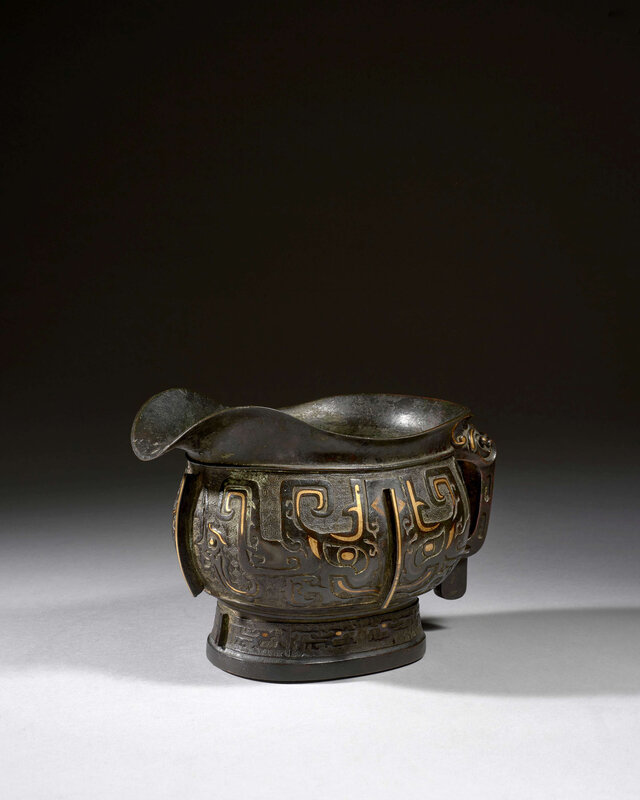
Lot 42. A gold and silver inlaid bronze ewer, Gong, China, Song-Ming dynasty, 13th-15th century. H. : 21,1 cm (8 ¼ in.) L. : 32 cm (12 ½ in.). Estimate 25 000 €-35 000 €. © Artcurial
Reposant sur un haut pied ciselé de dragons gui stylisés sur fond de grecques, la panse bombée, ornée de grands masques de taotie archaïsants, les arrêtes et traits principaux soulignés d'or, une anse à l'opposé du bec verseur surmontée d'une tête d'animal fantastique
Note: La forme en verseuse Gong pour un récipient en bronze archaïsant incrusté d'or et d'argent est rare. Ces productions réalisées entre les Song et les Ming, reprennent les formes des bronzes archaïques comme les Gui, les Hu, les verseuses en forme de canard ou tapirs. Pour une discussion sur ces bronzes incrustés, voir l'ouvrage de Rose Kerr, Later Chinese Bronzes, Victoria and Albert Museum, pages 50 à 55, et ill 4, p.16 et ill. 13, p. 22.Voir aussi les lots vendus à Christie's Londres le 15 mai 2018, Lot 77, Christie's Hong Kong, le 4 octobre 2016, Lot 35 ou Sotheby's Hong Kong, le 8 octobre 2014, Lot 3350.
The Gong form for silver and gold inlaid bronze archaistic ewer is rare. These vessels were made during Song to Ming periods in the revival of archaic bronzes Gui, Hu, duck-shape or tapir ewers. For a discussion on inlaid bronzes, see Rose Kerr, Later Chinese Bronzes, Victoria and Albert Museum, pages 50 à 55, et ill 4, p.16 et ill. 13, p. 22. See also the bronzes sold at Christie's London, 15 May 2018, Lot 77, Christie's Hong Kong, 4 October 2016, Lot 35 or Sotheby's Hong Kong, 8 October 2014, Lot 3350.
Lot 89. A fine white jade bowl and cover, China, Qing dynasty, Qianlong period (1736-1795). D. : 12,3 cm (4 ¾ in.). Estimate €12,000 - €18,000 © Artcurial
Reposant sur un petit pied droit, la bordure tulipée, le couvercle surmonté d'une prise circulaire évasée, la surface polie, la pierre d'une belle couleur blanche.
Provenance : Collection Jules et Jean LALIERE à Namur, n°21 de l'inventaire, selon une étiquette au verso ;
Vente de la collection Comte Cavens Galerie le Roi en 1922, n°101 du catalogue ou il est reproduit.
Note: La couleur et la transparence de la pierre, presque sans faille, le poli et l'élégance de la forme montre l'excellence de cette pièce. Un bol couvert identique, provenant de la collection Alan et Simone Hartman a été vendu à Christie's New York, le 19 mars 2009, lot 625 ; une autre paire de bols couverts du XVIIIe siècle, est publiée dans le catalogue de S. Bernstein & Co. Oriental Art, Chinese Jade From Distant Centuries, San Francisco, 1992, no. 39.
The color and transparency of the jade, almost flawless, the polish and elegance of the shape show the excellence of this piece. An identical bowl and cover from the Alan et Simone Hartman collection was sold at Christie's New York, 19th March 2019, lot 625; another pair of bowls and covers of the 18th century is published in the catalogue of S. Bernstein & Co. Oriental Art, Chinese Jade From Distant Centuries, San Francisco, 1992, no. 39.
An important and rare twelve-sheet black and gold lacquer and paper screen will also undoubtedly create a stir amongst the bidders. From the Qing Dynasty, it is dated 1870, the tenth year of the reign of Tongzhi. The twelve panels are each composed of a central part on which are inscribed Mahayana Buddhist texts, originating in the North of India and spreading later to China and the rest of Asia. They are signed by Zongshi Yan Xu, the calligrapher associated to the Imperial Family (estimate: €5,000 and 7,000).
Lot 94. An important and rare twelve-fold gilt and black lacquer and gold paper screen, China, Qing dynasty, dated as tenth year of Tongzhi reign, 1870. Dimensions d'une feuille : 161 x 33,8 cm (63 ½ x 13 ¼ in.). Estimate €12,000 - €18,000 © Artcurial
Les douze panneaux composés d'une partie centrale en papier à fond or inscrit des textes bouddhiques du mahayana, titrés Foshuo Amituo Wu Liang Shou Jing, et datés Tongzhi Shiniansui (dixième année du règne de Tongzhi) suivie de la signature du calligraphe Zongshi Yan Xu, encadrée d'une fine broderie et tendue dans un cadre de bois laqué noir et or à décor de chauves-souris, nuages, lotus, médaillons et rinceaux, le revers en bois laqué noir, les ferrures métalliques en forme d'aiguilles ; déchirures et manques au papier, usures, manque le socle d'origine
Note: La calligraphie inscrite sur la partie or du paravent porte le titre Foshuo Amituo Wu Liang Shou Jing, du Sutra de Vie-Infinie du bouddhisme Mahayana, la fin du texte mentionne la date Tongzhi Shiniansui (dixième année du règne de Tongzhi) suivie de la signature et des cachets du calligraphe Zongshi Yan Xu (Yan Xu apparenté à la famille impériale). Yan Xu (?-1887), était Directeur Général du Protocole à la cour impériale.
The inscribed calligraphy on the gold part of the screen is entitled Foshuo Amituo Wu Liang Shou Jing, Infinite Life Sutra from the Mahayana. The end of the calligraphy is dated Tongzhi Shiniansui (tenth year of Tongzhi reign) followed by the signature and seals of Zongshi Yan Xu (Yanxu related to the imperial family). Yan Xu (?-1887) was Head of Protocol of the imperial court.
A Hu porcelain vase with Guan type glazing dating from the Qing Dynasty and Qianlong period from the collection of a Parisian enthusiast is sure to attract a great deal of interest. The hexagonal balustrade shape is covered with pale celadon glaze and carries an estimate of €15,000 - 20,000.
Lot 73. A Guan-type porcelain Hu vase, China, Qing dynasty, Qianlong mark and period (1736-1795). H. : 33,5 cm (13 ¼ in.). Estimate €15,000 - €20,000 © Artcurial
De forme hexagonale balustre, reposant sur un pied légèrement évasé, recouvert d'une belle glaçure céladon pâle légèrement craquelée, le col orné de deux anses tubulaires, marque à six caractères Qianlong à la base ; col rodé, accident et fêles au col, éclats au pied.
Provenance : Collection d'un amateur parisien.
Note: Un vase identique a été vendu à Christie's Hongkong le 30 novembre 2011, lot 3315 ; un autre vase a été vendu à Sotheby's Hongkong le 8 avril 2013, lot 3070. Un vase plus grand portant la marque Yongzheng est illustré dans The Complete Collection of Treasures from the Palace Museum, Monochrome Porcelain, vol. 37, Hong Kong, 1999, P. 226, pl. 204.
An identical vase was sold at Christie's Hongkong 30th November 2011, lot 3315; another one was sold at Sotheby's Hongkong, 8th April 2013, lot 3070. A larger Yongzheng-marked Guan-type vase of this form in the Palace Museum Collection, Beijing is illustrated in Monochrome Porcelain, The Complete Collection of Treasures from the Palace Museum, vol. 37, Hong Kong, 1999, no. 204.
Other remarkable lot: a vase covered in monochrome celadon porcelain, Qianlong period, marked by six Qianlong characters at the base (estimate: €20,000 - 30,000).
Lot 139. A celadon-glazed ovoid jar and cover, Yue Ya Er Guan, China, Qing dynasty, Qianlong mark and period (1736-1795). Estimate €15,000 - €20,000 © Artcurial
De forme ovoïde, recouvert d'une belle glaçure céladon pâle, les anses en léger relief en forme de croissant, marque à six caractère Qianlong à la base ; couvercle cassé en deux et restauré.
Note: Un vase similar est illustré dans Treasures in The Royalty, The Official Kiln Porcelain of The Chinese Qing Dynasty, p. 338; un autre vase sans couvercle a été vendu à Christie's New York 22 March 2018, lot 615
A similar vase is illustrated in Treasures in The Royalty, The Official Kiln Porcelain of The Chinese Qing Dynasty, p. 338; another vase without cover was sold at Christie's New York 22 March 2018, lot 615.
Japanese art will be represented by a large piece of partially glossed hinoki and keyaki wood mizuya kitchen furniture. The Meiji period (1868-1912) piece of furniture carries an estimate of between €800 and 1,200.
Among the emblematic objects from Japanese culture, a set of twenty-six ink and colour paintings on silk from the latter part of the 19th - early 20th century, decorated with birds, butterflies, dragonflies and various flowers (estimate: €6,000 - 8,000 ) and a 20th century satsuma porcelain dish in the shape of a fan adorned with medallions of scenes representing characters with Mount Fuji in the background (estimate: €200 - 300).
Lot 13. Twenty-six paintings, ink and color on silk, Japan, late 19th-early 20th century. Dimensions : 22,5 x 16,5 cm (9 x 6 ½ in.). Estimate €6,000 - 8,000 © Artcurial
A décor d'oiseaux (grues, aigle, oie, martin-pêcheur, hirondelles, moineaux, etc…) perchés ou en vol, insectes (sauterelles, papillons, libellules, etc...), grenouille, souris, singe et fleurs diverses, cachets, encadrées.
The Art of Southeast Asia
The Art of Southeast Asia will bring this auction to a close with a large 12th century black stone Buddhist stele from Northern India. Representing Vishnu, the second God of the Hindu trinity, standing on a lotus, wearing a tiara and decked in jewellery, he is accompanied by his companions Sarasvati and Sri Bhu (estimate €10,000 - 15,000).
Lot 186. A black stone stele depicting Vishnu, North India, Pala period, 12th century. H. : 105,5 cm (41 ½ in.). Estimate €10,000 - 15,000. © Artcurial
Représentant Vishnu debout en samabhanga sur un lotus et devant une mandorle sur un socle en forme de lotus au-dessus d'une frise sculptée d'adorants, les quatre bras tenant ses attributs, le visage serein, les yeux en amande, coiffé d'une tiare et paré de bijoux, accompagné de ses compagnes Sarasvatî tenant le vina et Sri Bhu le chasse-mouche, socle en métal ; manques visibles.
Tibetan culture will also be represented with a partially gilt copper statuette of Milarepa, magician, Yogi and Tibetan poet, here dressed in monastic garb. This piece, dating from the 19th century carries an estimate of between €1,500 and 2,000 €.
Finally, a 17th century gold lacquered wood statue of Buddha will illustrate Thai art (estimate: €6,000 - 8,000), while a 17th century sandstone divinity head will represent Cambodian Khmer art (estimate: €3,000 - 4,000).
Lot 192. A gilt-lacquered wood figure of Buddha, Thailand, Sukhotai, Chieng Saen style, 17th century. Estimate €6,000 - 8,000. © Artcurial
Représenté debout reposant sur une base circulaire, vêtu d'une longue robe monastique, les mains croisées, le visage serein, les cheveux en boucles surmontés d'une flamme ; manques à la laque, fente en dessous du coude.
Publication : A. Bassoul, Human and Divine - The Hindu and Buddihist Iconography of Southeast Asian Art from the Claire and Aziz Bassoul Collection, Beirut 2006, p. 248, fig.98
Lot 190. A sandstone head of a deity, Cambodia, Khmer Art, Angkor Vat style, 12th century. H. : 21 cm (8 ¼ in.). Estimate €6,000 - 8,000. © Artcurial
Le visage serein, les yeux en amande surmontés de sourcils droits, la bouche charnue, les cheveux coiffés en un haut chignon gravé d'un emblème sur le dessus, le front ceint d'une tiare ouvragée.

/https%3A%2F%2Fprofilepics.canalblog.com%2Fprofilepics%2F1%2F0%2F100183.jpg)
/https%3A%2F%2Fstorage.canalblog.com%2F03%2F02%2F119589%2F96711876_o.jpg)
/https%3A%2F%2Fstorage.canalblog.com%2F11%2F31%2F119589%2F94773502_o.jpg)
/https%3A%2F%2Fstorage.canalblog.com%2F20%2F83%2F119589%2F94772815_o.jpg)
/https%3A%2F%2Fstorage.canalblog.com%2F26%2F72%2F119589%2F75604929_o.jpg)
/https%3A%2F%2Fstorage.canalblog.com%2F59%2F60%2F119589%2F26458628_o.jpg)







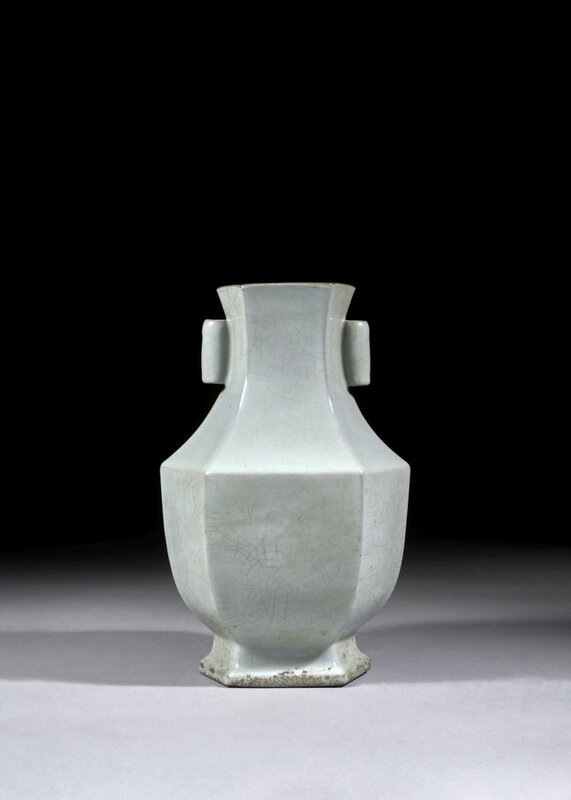





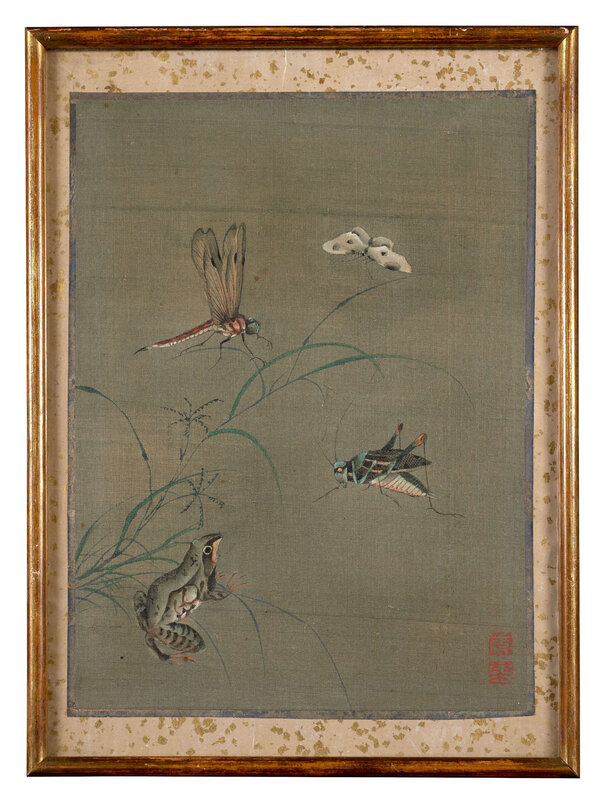











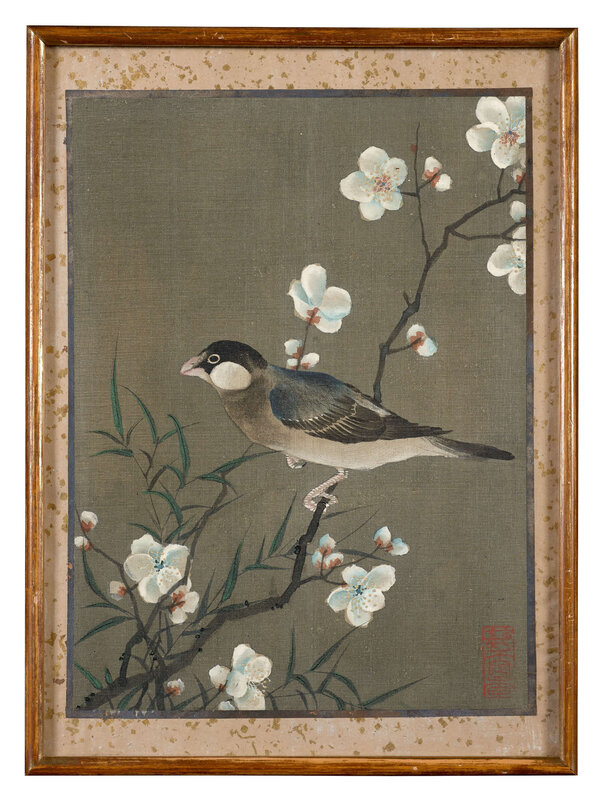
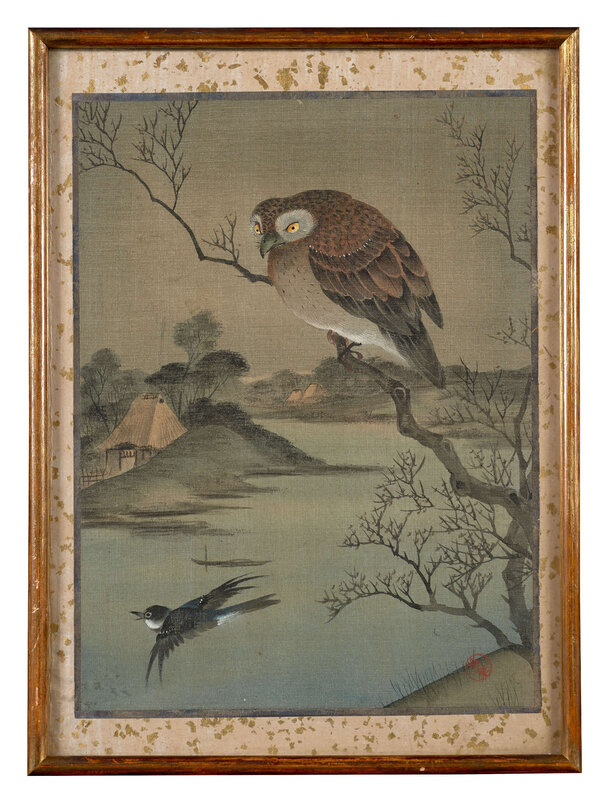
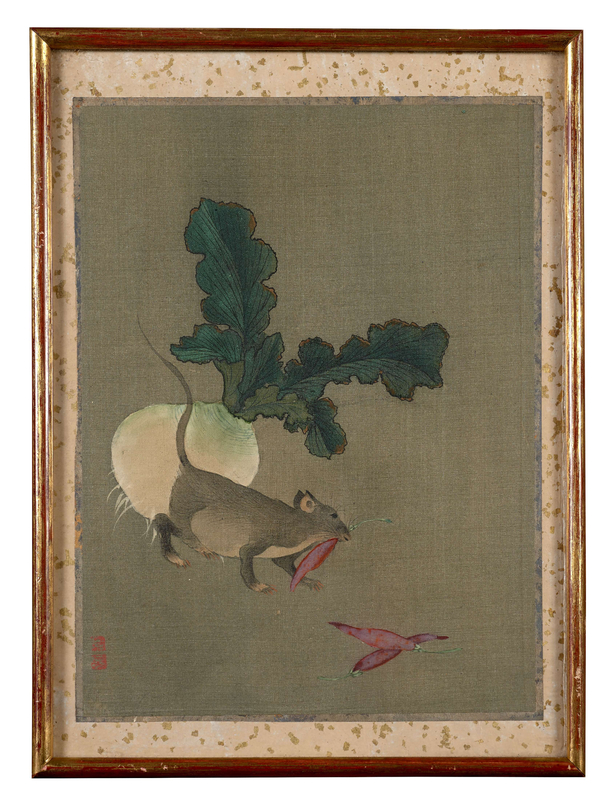


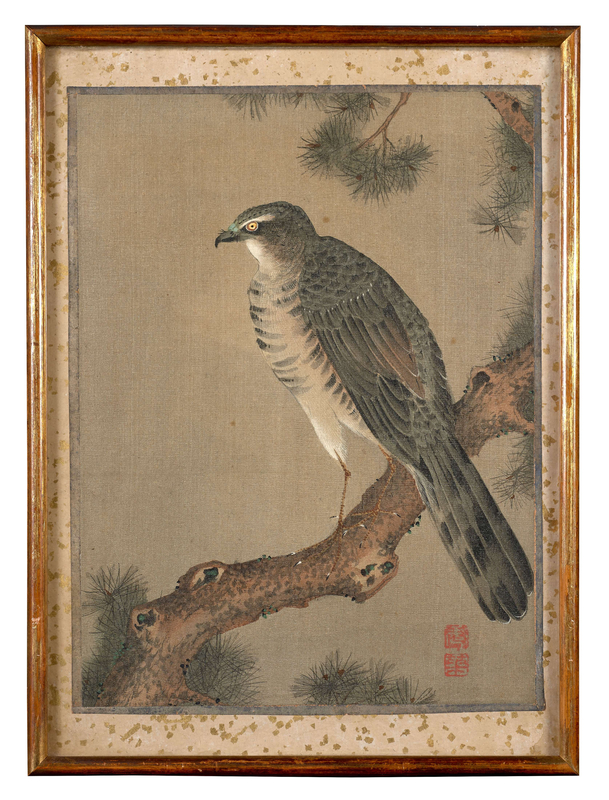


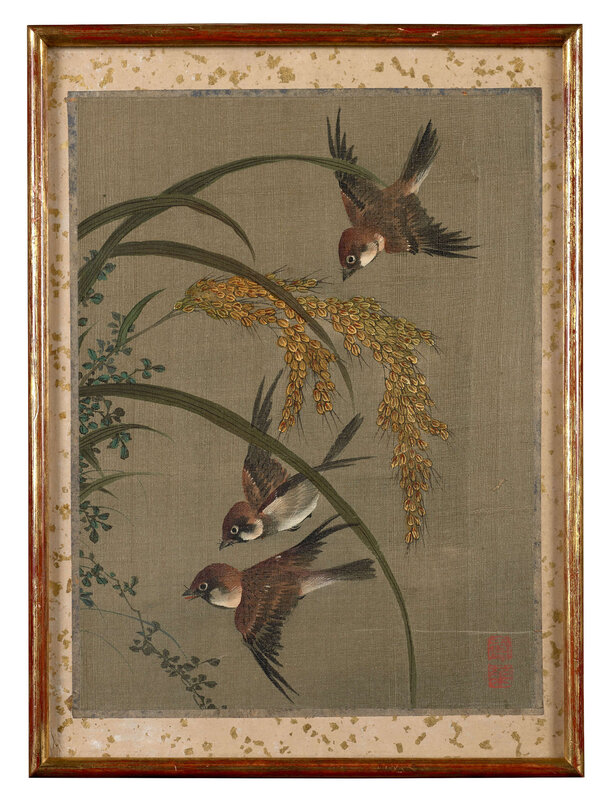











/image%2F1371349%2F20240326%2Fob_936d86_104-1.jpg)
/image%2F1371349%2F20240326%2Fob_823710_102-1.jpg)
/image%2F1371349%2F20240326%2Fob_55a293_101-1.jpg)
/http%3A%2F%2Fstorage.canalblog.com%2F33%2F99%2F119589%2F129627838_o.jpg)